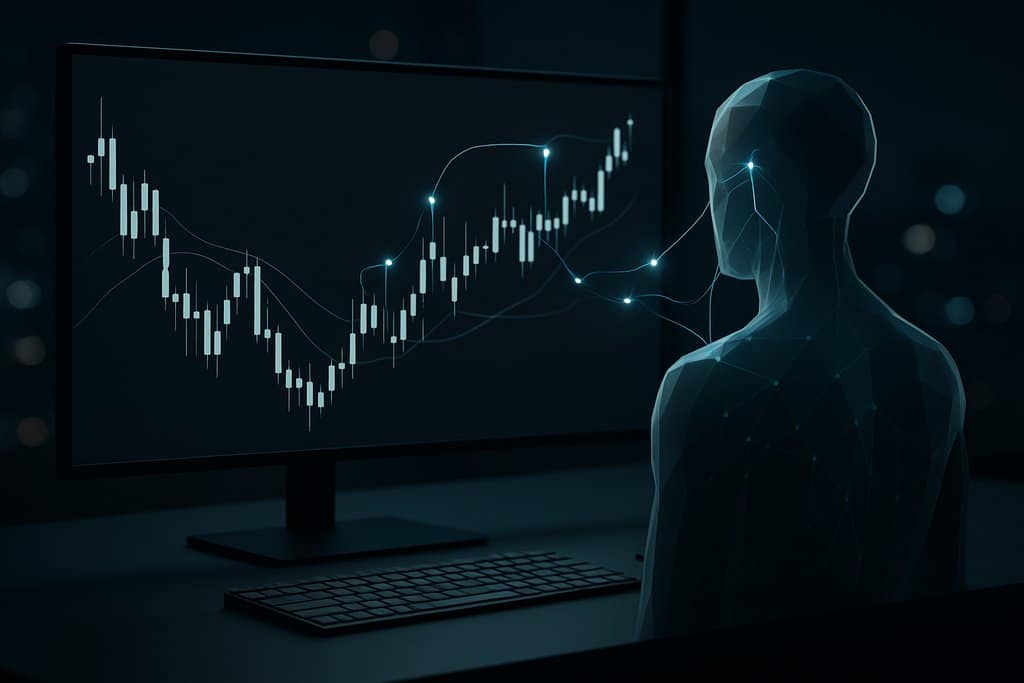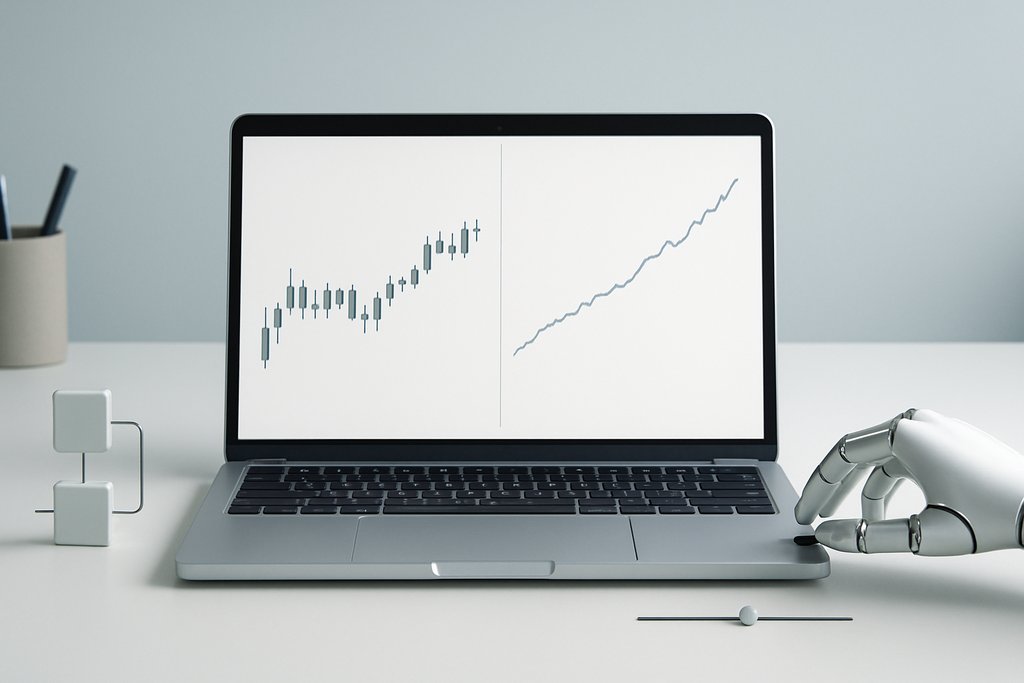A I Trading Bot: Automate Strategies and Execution Fast
Learn how an a i trading bot turns plain-language ideas into automated market actions. See practical setups, risks, and how Obside helps you go live fast.

Table of contents
- Why traders use an a i trading bot
- What is an a i trading bot
- How modern bots work
- Use cases and examples
- Build your bot in five steps
- Benefits and considerations
- Evaluating performance
- Obside: idea to execution
- Practical examples
- FAQs
- Conclusion and next steps
Why traders use an a i trading bot
If you are searching for an a i trading bot, you likely want faster execution, less manual monitoring, and a way to systematize the strategies you believe in. Markets move fast, information overload is real, and even diligent traders miss opportunities when juggling charts, news, and risk controls.
The promise is straightforward: you define what matters, the bot listens to the market and the news, then acts consistently and instantly. This guide explains how that promise is delivered in practice, what to watch out for, and how to build your own actionable setup using platforms like Obside.
What is an a i trading bot?
An a i trading bot is software that automates trading decisions using data-driven logic, machine learning, or intelligent rule systems. It ingests market prices, technical indicators, and sometimes fundamental or alternative data, then generates signals to buy, sell, rebalance, or alert you when conditions you care about occur.
This sits inside the broader world of algorithmic trading. If you want a primer, see Wikipedia’s overview of algorithmic trading. The core advantage is not magical prediction, but precise, fast, and consistent execution that reduces impulsive decisions.
For a deeper product-focused perspective on building rules you can trust, browse our guide on algorithmic trading and how it connects to real orders.
How modern a i trading bots work
Under the hood, an a i trading bot follows a simple pipeline once you break it down: data collection, feature construction, signal generation, execution, and evaluation.
First, data is collected and cleaned: prices, volume, order book snapshots, plus macro events or company news. Second, features are built from the data. Think RSI, MACD, ATR, moving averages, or more advanced signals derived from price action and volatility. For accessible explainers, see RSI, MACD, and ATR on Investopedia.
Third, signals are generated: pure rules like “buy when RSI crosses above 50 and MACD turns positive” or model-based probabilities of favorable moves. Fourth, orders are executed via connected brokers and exchanges. Slippage, latency, and liquidity matter, so robust execution and risk controls are essential. Finally, performance is tracked and refined through backtesting and live metrics.
Obside simplifies this entire pipeline. With Obside Copilot, you describe what you want in plain language, and Obside turns intent into concrete market actions. You can create smart alerts, trigger automatic orders, or manage whole portfolios with your own rules — tied to prices, indicators, news, or macro data. For choosing tools to test strategies properly, see backtesting software.

Use cases and strategy examples with an a i trading bot
Most traders start with simple, transparent rules, then add complexity as confidence grows. Your a i trading bot can scan and act across markets, timeframes, and data types.
Momentum and mean reversion are popular. A bot might look for a bullish RSI divergence on a 15 minute chart, then enter with a stop at the day’s low and a fixed take profit. Trend followers often rely on Supertrend confirmation across timeframes, plus an RSI filter to avoid overbought entries, and a trailing stop based on ATR to protect gains. If you are new to RSI, explore our detailed RSI indicator guide.
Event-driven logic is where Obside excels. You can define actions tied to real-time news and macro triggers: reduce exposure if tariffs are announced, buy a defined amount of oil if a hurricane hits, or rebalance when volatility surges. Obside lets you automate these instantly.
- Alert me if Bitcoin rises above 150,000 dollars and daily volume doubles.
- Notify me if RSI crosses 70 on EUR USD and MACD turns bearish.
- Buy 50 dollars worth of Tesla if a specific social event occurs.
- Keep 50 percent in Bitcoin, 25 percent in Ethereum, and 25 percent in USDC.
Use RSI divergence for entries, add a 10 percent take profit and a stop at the day’s low, then monitor results with forex backtesting.
Building your first a i trading bot in five steps
Step 1. Define objectives and constraints
Be explicit. Are you trend following on a two hour chart, capturing short term momentum, or balancing a portfolio? Set a risk budget, maximum drawdown, and allowed markets. Clarity makes your logic resilient.
Step 2. Connect your broker or exchange
Obside integrates with major venues so your bot can place orders automatically. Start with alerts only, then upgrade to live trading once you are comfortable. Explore the platform at beta.obside.com and register at beta.obside.com/register.
Step 3. Describe your rules to Obside Copilot
Example: when Supertrend becomes bullish on the 2 hour chart, RSI is not overbought, and Supertrend on the 8 hour chart is also bullish, then buy. For selling, reverse the logic. Add a trailing stop at 5 ATR on the 2 hour chart, and close the position if Supertrend on the 2 hour chart changes direction. Obside translates this into an executable strategy without coding.
Step 4. Backtest in seconds
Backtesting checks rules against historical data to validate entry quality, risk behavior, and overall performance. See Investopedia’s backtesting overview. Obside’s ultra fast engine lets you iterate quickly. For picking the right tooling, review our backtesting software guide.
Step 5. Go live with monitoring and alerts
Start small and enable notifications for key events. Obside can raise alerts on price levels, indicator crossings, and news triggers so you stay informed. As confidence grows, scale position sizes responsibly.
Benefits and considerations of an a i trading bot
The main benefits fall into several categories. You gain speed by acting the moment conditions occur, consistency from rules that remove impulse, coverage across markets and timeframes, data richness by combining technical and event signals, and discipline from enforced risk controls.
- Act instantly when conditions trigger
- Execute rules consistently without emotion
- Monitor multiple markets and timeframes
- Combine technical and event-driven signals
- Enforce position sizing and stops automatically
Important considerations include overfitting, data quality, execution costs, and explicit risk management. A model that looks perfect in backtests may fail live if it is too complex or curve-fit.
Evaluating performance the right way
Look beyond headline returns. Track win rate together with average win versus average loss size, maximum drawdown, and the Sharpe ratio for return per unit of volatility. For a refresher, see Sharpe ratio.
Make out-of-sample testing a habit. Split history into training and testing windows. Validate across different regimes like low volatility grind, high volatility spikes, and trend break phases. If your a i trading bot performs acceptably across conditions, it is more likely to hold up live.
Monitor live slippage and fees. Backtests often assume perfect fills, but real fills vary with liquidity and volatility. Track execution quality and adjust limits or position sizes accordingly. For portfolio-level testing, see backtest portfolio.
Simple, well-tested rules across regimes beat complex curve-fit in live markets.
Obside: from idea to a i trading bot in seconds
Obside is a financial automation platform that turns plain language into concrete market actions. Describe what you want, and Obside Copilot builds it. Use it for alerts, automatic orders, or full portfolio management tied to prices, indicators, news, or macro data.
Sell your stocks if new tariffs are announced, buy oil when a hurricane hits, or rebalance when volatility spikes. With its ultra fast backtesting engine, you validate strategies in seconds, then run them automatically through connected brokers and exchanges. If you are comparing solutions, our guide to the best automated trading platforms and AI trading software can help.
Chat your strategy in plain language, backtest instantly, then deploy with real orders. Recognized by professionals for speed from idea to execution.
Practical examples you can try today
If you want to see a i trading bot logic in action without writing code, here are examples you can set up with Obside in minutes.
Example 1. Momentum entry with risk controls
Buy when there is a bullish divergence on RSI on a 15 minute chart. Set a stop loss at the low of the day and a take profit at 10 percent. This pairs a technical entry with clear exits.
Example 2. Trend confirmation across timeframes
When Supertrend turns bullish on the 2 hour chart, RSI is below 70, and Supertrend on the 8 hour chart is also bullish, buy. For selling, reverse the logic. Add a trailing stop at 5 ATR on the 2 hour chart to protect gains.
Example 3. Event-driven allocation shift
Keep 50 percent in Bitcoin, 25 percent in Ethereum, and 25 percent in USDC. If daily volatility on Bitcoin spikes beyond a threshold, rebalance to reduce exposure until conditions normalize.
Example 4. News reaction with caps
Buy 1000 dollars of Bitcoin if the price is below 100,000 dollars and a major news event indicates short term tailwinds. Cap exposure with a max position size and a time-based exit if price fails to break higher.
FAQs
What is the difference between an a i trading bot and a basic algorithmic bot?
A basic algorithmic bot follows fixed rules with minimal adaptation. An a i trading bot can integrate machine learning, natural language understanding, and richer data sources to make context-aware decisions. In practice, both rely on predefined logic, but AI-driven tools help you create, iterate, and react faster with nuanced inputs.
Can beginners use an a i trading bot effectively?
Yes, if they start simple. Begin with transparent rules like price-level alerts or a single indicator crossover. Validate with backtesting, use small position sizes, and add complexity only after you understand how each component affects performance. Platforms like Obside help beginners by turning plain language into working strategies.
Which data sources matter most for an a i trading bot?
Price and volume are foundational. Technical indicators such as RSI, MACD, and ATR add structure. News and macro triggers can improve responsiveness when combined with risk controls. Data quality and timeliness are critical, since delayed or noisy inputs weaken signals.
How do I measure whether my a i trading bot is performing well?
Track returns alongside risk metrics like maximum drawdown and Sharpe ratio. Compare backtested expectations with live results to spot slippage or execution issues. Review win rate together with average win and average loss sizes.
Is Obside suitable for both alerts and fully automated trading?
Yes. Start with alerts for key conditions, then upgrade to automatic order execution and full portfolio management when ready. Obside’s Copilot lets you define everything in plain language, and the backtesting engine helps you validate before going live.
Conclusion and next steps
An a i trading bot helps you act faster, more consistently, and across more signals than any human can manage alone. Define rules and risk, let the bot listen, alert, and execute, then iterate through backtests and live trials to harden your edge.
Write down the conditions that truly matter to your trading. Translate those rules into plain language, feed them to Obside Copilot, backtest quickly, refine parameters, and deploy with modest size. As confidence grows, scale responsibly. The distance between idea and execution can be measured in seconds, not weeks.






